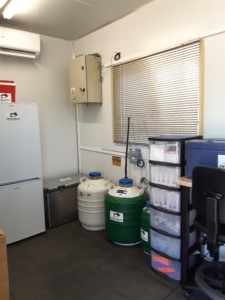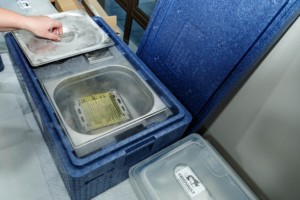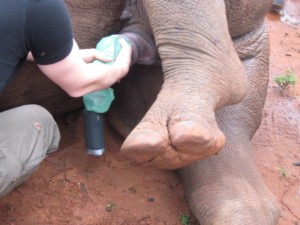The African rhinoceros’ crisis: What can reproductive biologists do?

Fig. 1: African white rhinoceros shortly after darting (horns have been cut so that poachers may be less interested).
There are two species of African rhinoceros, the black rhinoceros, Diceros bicornis, and the white rhinoceros, Ceratotherium simum (Fig. 1). South Africa hosts the largest population of these rhinos (>80%) but it is well known that their numbers have been dwindling since the 1990’s and the white rhinoceros is classified as near threatened and the black rhinoceros listed as critically endangered (IUCN criteria). In February 2013 records show that 2.2 rhinos were killed per day! The major problem is that rhino horn is considered a traditional medicine (no scientific basis, just keratin like from your nails) in several Eastern countries such as China, South Korea and even used for certain ceremonial ceremonies in Yemen.
About 25% of South African rhinos live on private owned land and these wildlife farms hire expert security services at a high cost as well as using remotely piloted air craft systems to assist with protection of these valuable wildlife species. However, despite these measures poaching of rhinos seems to have no end.
What can biologists and veterinarians do to assist in the protection and survival of the rhino species, particularly in South Africa? During 2009/2010 major research groups from Germany and South Africa combined forces with major financial backing from Zoological Parks in France and the USA to dart (Fig. 2) collect, characterize and freeze sperm from free ranging rhinos (Fig. 3). Private game reserves were targeted in the North of South Africa and also in the vicinity of Pretoria. This was one of the first attempts to quantify through computer aided sperm analysis sperm quality of these species in the wild and also apply and refine cryo-preservation techniques of their sperm.
- Fig. 2: Preparation for semen collection after darting.
- Fig. 3: Artificial condom for semen collection.
While the above attempts formed an important basis and beginning to quantify rhinoceros’ sperm quality it is simply not enough to save the species from extinction. One of the worst-case scenarios would be to fail at protecting rhinos from poaching in South Africa and Zimbabwe. This is why the Hemmersbach Rhino Force (HRF) Cryovault biobank was established (Fig. 4). HRF is a Direct Action conservation organization protecting one of the most endangered species on earth. Direct Action means that it finances itself completely, autonomously and free of charge. HRF had to become more than just an anti-poaching organization and one of the important reasons why the Rhino Force Cryovault in South Africa was formed. Two of the co-authors of this blog, Dr. Imke Lüders (renowned wildlife veterinarian) from Hamburg, Dr. Ilse Luther (expert in wildlife assisted reproduction) from South Africa were asked to join the team and lead the Cryovault project.

Fig. 4: Showing a section of Cryovault facilities with liquid nitrogen tanks where sperm are stored at -196ºC.
What is the Cryovault Bank and project? The aim is to cryo-preserve (deep freezing) semen, ova and in the future hopefully embryos of predominantly rhinoceros but also elephant and other wildlife species. Accordingly, this approach assists greatly to conserve the genetic diversity for future generations and will facilitate future assisted reproduction applications such as insemination.
Apart from the sperm and oocytes that are cryo-preserved, tissues and cells from rhinos are stored indefinitely by cryo-conservation. Consequently, this frozen archive contributes to the research of DNA population genetics, but more importantly, can be directly applied in current rhino breeding through assisted reproduction technologies. This is a crucial step for future rhino conservation and forms a “safety net” against genetic diversity loss.

Fig. 5: Straws with rhinoceros’ semen in cryo-protectant/extender in liquid nitrogen before final storage in liquid nitrogen tanks.
Finally, the objective is to build the largest Cryovault facility for African rhino genetics in the world by sampling post-mortem and fresh cells and tissues. Moreover, we want to establish a reference database for this species. Any material collected will be banked alongside with animal biometrical, environment and location data, which provides a comprehensive background of information for studying of population dynamics.
In the first year of Cryovault hundreds of semen straws (Fig. 5) of different rhinos and elephant bulls have been successfully stored and this already provides hope for the future propagation and genetic diversity management of these species.
Prof Gerhard van der Horst (PhD, PhD, Senior consultant to Microptic)
Dr Ilse Luther# (PhD, Rhino Force Cryovault, South Africa)
Dr Imke Lueders # (DVM, PhD, Rhino Force Cryovault, Hamburg, Germany)
#hemmersbachrhinoforce #cryovault






Leave A Comment